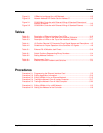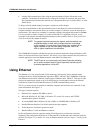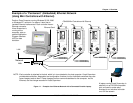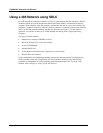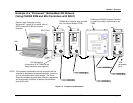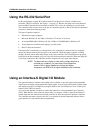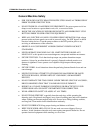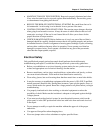
CS4000 Mini Controller with Ethernet
Page
1-6
T-38324-A 39-30-38324
Using the RS-232 Serial Port
In this configuration, a laptop PC loaded with the Visual Supervisor software is linked to the
controller’s RS-232 serial port. See Figure 1-1 on page 1-3. Because the laptop can be disconnected
from one Mini Controller and reconnected to another, VS is said to be operating in portable mode.
The controller in this scenario may not be part of a network typically so that it, the cable and nutrunner
comprise a stand-alone fastening system.
This type of operation requires:
• Pentium class laptop computer.
• Microsoft Windows 95, 98, 2000, or Windows NT version 3.0 or above.
•
At least 64 MB RAM for Windows 95, 98 or 2000, or 128 MB RAM for Windows NT.
• Visual Supervisor installed on the laptop in portable mode.
• RS-232 cable and connector.
If the laptop PC is connected to a controller that is also connected to a network, the host computer
adopts any changes made by the laptop PC to the controller. While the laptop computer is making
changes, the host cannot make setup changes to the same controller. The Visual Supervisor program
being run by the host computer grays out every field for that particular controller. When the laptop PC
is no longer connected to the controller, the host computer can once again make changes.
NOTE: To attach and use a laptop to view, edit or collect data from a
controller on a network, you must have Visual Supervisor
version 3.20 or higher installed on the host and laptop
computers, and DCM 4.06 or higher installed on the controllers.
Using an Interbus-S Digital I/O Module
The optional Interbus-S module can be added to the controller, to provide eight soft-programmable
digital inputs and eight soft-programmable digital outputs. You can assign the function of these inputs
and outputs using the Visual Supervisor program. Refer to the Visual Supervisor User’s Guide (part
number 39-40-34823) for details.
You can use the Interbus-S module to connect the controller to a Programmable Logic Controller
(PLC). When the PLC reads a barcode successfully, for example, it sends a signal as an Interbus-S
module input into the controller that tells the controller to allow the operator to perform a rundown.
The controller then sends a signal to the PLC as an Interbus-S module output that indicates when a
good rundown or a bad rundown has been performed.




